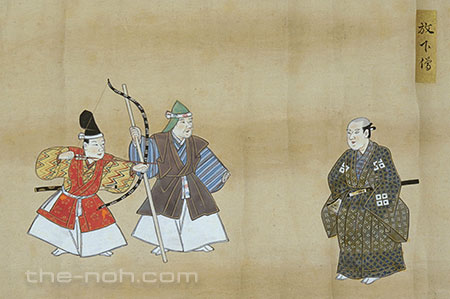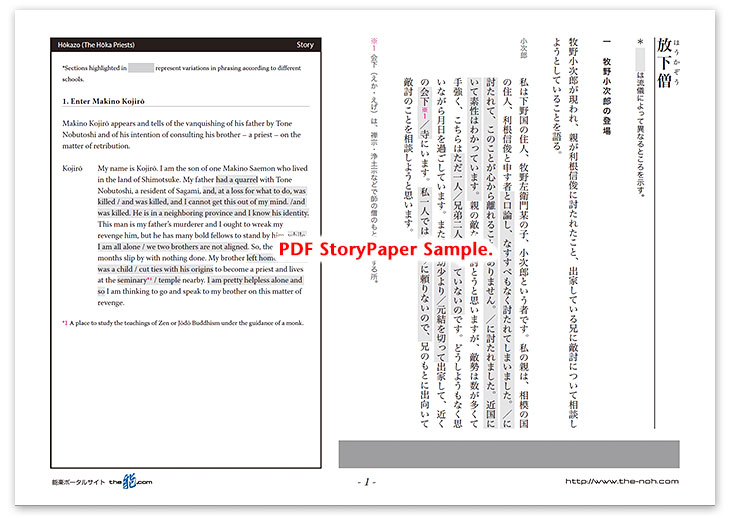
 Hōkazo (The Hōka Priests)
Hōkazo (The Hōka Priests)

![]()
Kojirō, the child of Makino Saemon, who was defeated in a dispute with Tone Nobutoshi in Sagami Province (located in what is today the central and western portion of Kanagawa Prefecture), has decided to take revenge on his father’s enemies. In order to defeat the numerically superior Tone clan, Kojirō goes to seek help from his older brother, who renounced the world (for a priestly life) at an early age. The older brother urges him to bide his time, but on hearing Kojirō’s assertions that he will be unhappy until he defeats his father’s enemies, agrees to accompany his brother on the quest to avenge their father’s death. To deceive Tone, they dress themselves as hōka*– street players, who were fashionable at the time.
Plagued by bad dreams, meanwhile, Tone decides to make a pilgrimage to Mishima. He takes with him Floating Cloud, Running Water – the unidentified hōka he encounters there. These hōka are none other than Kojirō and his older brother. Tone listens to the reasons the two give for the fan and bow they carry and takes pleasure in the Zen riddles he hears. The brothers perform various tricks while they wait for their moment to take vengeance on Tone. Catching Tone off his guard, the two brothers kill him thus fulfilling their long-held desire.
*Hōka refers to a type of street performance that draws from the traditions of Dengaku (rustic celebrations that developed as a musical accompaniment to rice planting observances) and was performed from the middle ages to early modern times. Hōka were itinerant performers who traveled from place to place carrying (a musical instrument called the) kokiriko – short lengths of thin bamboo that are struck together when dancing – and singing folk songs. Some hōka players (hōkazō) donned priestly attire, others (hōkashi) adopted a more vulgar style.
![]()
Whilst this is a story of two brothers who come together to take vengeance on their enemy, the contrasting image of the brothers, Kojirō who is full of passion and his older brother who never loses his composure, is clearly delineated. Tone, whilst the villain of the piece, meanwhile, shows presence in his reluctance to let down his guard and (in) his understanding of the performing arts and Zen doctrine, whilst the servant in the kyōgen interval is depicted as a man who is obedient to Tone even as he makes something of a fool of himself. The relationships woven by the four characters thus make for a dramatic story. The bows, sword, fan and other accoutrements of the hōka also add color to the stage.
The play incorporates various forms of entertainment, including kusemai (storytelling with dance), kakko (a Japanese hourglass drum), and kouta (“little songs”), which are performed (by the brothers) in an attempt to throw Tone off his guard, and the focus of this work is thus considered to be these performing arts. A number of other plays have dialogue interspersed with music, singing and dancing, including Kagetsu and Jinen-koji, among others. The play also includes a dialogue on Zen doctrine that, in drawing on a range of waka (Japanese poems) and Chinese folklore, gives added depth to the story.
STORY PAPER : Hōkazo (The Hōka Priests)
Story Paper presents noh chant stories in modern speech, with story outlines, highlights and more using Adobe PDF format, which can print out and zoom in. Print out the pages and take them with you when you see the actual noh performance.

The copyright of Story Paper is held by the Noh.com. Story Paper is for individual use only. It is prohibited by the copyright law to distribute or publish printed-out Story Paper pages without prior consent. For more information, check the credit and disclaimer pages.



 [Hōkazo (The Hōka Priests) : Story Paper PDF : 619KB
[Hōkazo (The Hōka Priests) : Story Paper PDF : 619KB